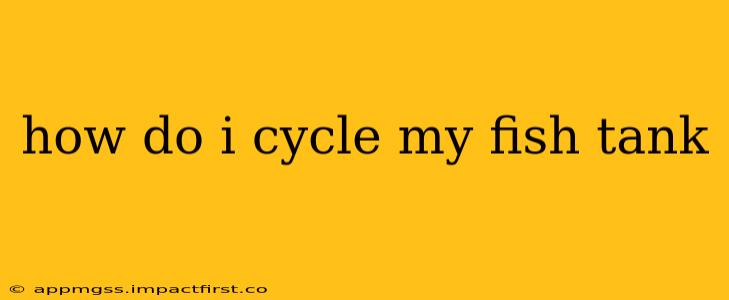Cycling a fish tank is crucial for creating a safe and thriving environment for your aquatic pets. It's a process that establishes beneficial bacteria colonies necessary to break down harmful waste products like ammonia and nitrite, turning them into less toxic nitrate. Skipping this vital step can lead to illness and even death for your fish. This comprehensive guide will walk you through the process, answering common questions and ensuring your tank is ready for its finned inhabitants.
What is the Nitrogen Cycle?
Before diving into the how, let's understand the why. The nitrogen cycle is a natural process where beneficial bacteria convert harmful fish waste into less harmful substances. This happens in several stages:
- Ammonia (NH₃): Fish waste, uneaten food, and decaying organic matter produce ammonia, a highly toxic compound.
- Nitrite (NO₂): Nitrosomonas bacteria convert ammonia into nitrite, which is also toxic, though less so than ammonia.
- Nitrate (NO₃): Nitrobacter bacteria then convert nitrite into nitrate, a much less toxic substance. Nitrate is still harmful in high concentrations, but it's manageable through regular water changes.
How Do I Cycle My Fish Tank? A Step-by-Step Guide
There are several methods to cycle your tank, each with its own pros and cons.
1. The Fish-Less Cycle (Recommended): This method is the most humane and ensures your tank is safe before introducing fish.
- Set up your tank: Add substrate, decorations, filter, and fill with water.
- Add ammonia source: You can use pure ammonia (make sure it's without additives like soaps or detergents!), fish food, or a commercially available ammonia solution. Aim for a dose that produces a reading of 2-4 ppm (parts per million) of ammonia. You can test this using a liquid test kit (test strips are less accurate).
- Monitor your levels: Test your water daily for ammonia, nitrite, and nitrate. Record your results.
- Patience is key: The cycling process typically takes 4-8 weeks, sometimes longer. You'll see the levels fluctuate as the bacteria colonies establish themselves. First, ammonia will decrease, then nitrite will increase, and finally, nitrite will decrease as nitrate increases.
- The Cycle is Complete: The cycle is complete when you can add ammonia and within 24 hours, it's converted to nitrite, and then within 24 hours after that it's converted to nitrate. You should have minimal to no ammonia or nitrite and measurable nitrate.
2. The Fishless Cycle Using Live Plants: This method leverages the natural processes of live plants to help kickstart the nitrogen cycle. While it can be slower than using an ammonia source, it's an environmentally friendly alternative.
- Set up your tank: Add substrate, decorations, filter, and fill with water. Include a diverse range of robust, fast-growing plants.
- Monitor your levels: Test your water regularly for ammonia, nitrite, and nitrate.
- Add more plants as needed: If you see a buildup of ammonia or nitrite, consider adding more live plants to help consume the waste.
3. The Fish-In Cycle (Not Recommended): This method involves adding fish to the tank early in the cycling process. While it may seem faster, it exposes your fish to toxic levels of ammonia and nitrite, which can cause severe illness and death. This method should only be used by experienced aquarists.
Frequently Asked Questions (FAQs)
How long does it take to cycle a fish tank?
The cycling process usually takes 4-8 weeks, but it can vary depending on several factors, including water temperature, the type of filter, and the bacterial load introduced to the system.
What are the signs of a fully cycled tank?
A fully cycled tank will show 0 ppm ammonia and nitrite, and a measurable level of nitrate. This indicates the beneficial bacteria are present and effectively processing the waste products.
What should I do if my tank isn't cycling?
Several things can hinder the cycling process. Ensure your filter is running properly, the water temperature is appropriate, and there is sufficient oxygen in the tank. If the process is taking an excessively long time, consider adding a commercial bacteria starter product.
What kind of test kit should I use?
Use a liquid test kit, as these are generally more accurate than test strips. Look for kits that test for ammonia, nitrite, and nitrate.
Can I add fish before my tank is cycled?
No, avoid adding fish before the tank is fully cycled. Doing so could result in the fish becoming sick or dying from exposure to toxic ammonia and nitrite.
Cycling your fish tank might seem daunting, but with patience and the right information, you can create a healthy environment for your fish to thrive in. Remember to always monitor your water parameters and be prepared to adjust your approach based on the readings you obtain. Happy fishkeeping!
